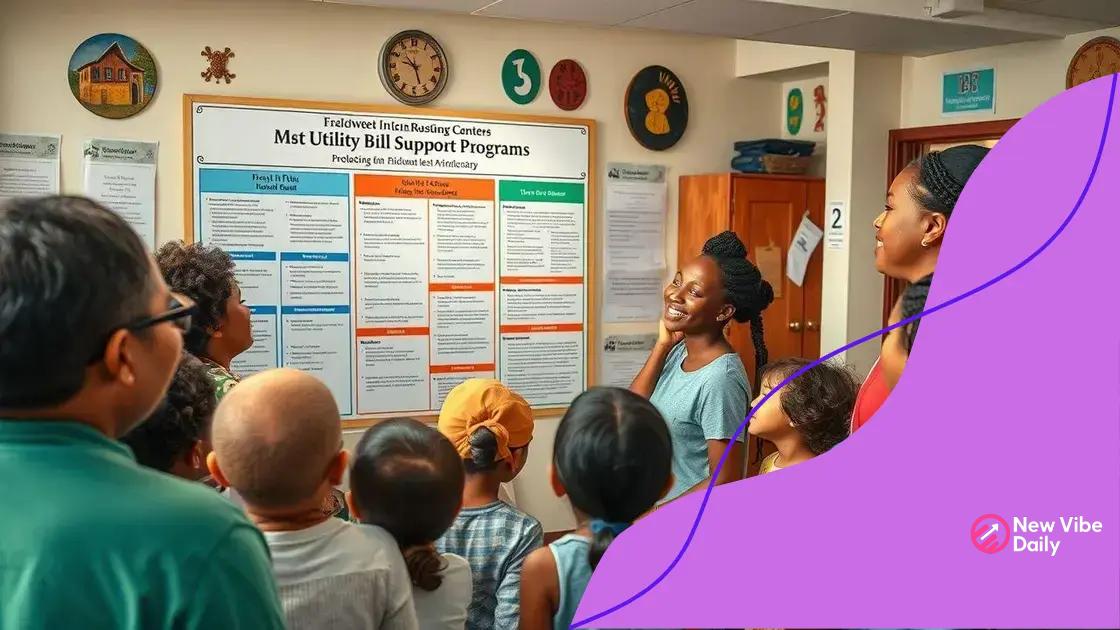Utility cost assistance: how to lower your bills

Utility cost assistance programs provide financial help to low-income households struggling with utility bills, ensuring families can maintain access to essential services like electricity, heating, and water.
Utility cost assistance can provide relief for many households struggling with high bills. Do you know how these programs work and whether you’re eligible? Let’s dive in and explore how you can benefit.
Understanding utility cost assistance programs
Understanding utility cost assistance programs is essential for households seeking support with their energy bills. These programs can directly help many families by covering a portion of their utilities. In this section, we will explore what these programs entail and how they can provide financial relief.
What are utility cost assistance programs?
Utility cost assistance programs are initiatives offered by governments and non-profit organizations to help low-income households pay their energy costs. These programs can be vital for those struggling to keep up with their monthly bills, especially during extreme weather conditions.
Types of programs available
- Direct payment assistance: Programs that provide direct payments to utility companies on behalf of eligible households.
- Discount billing: Some states offer discounted rates for qualifying customers, reducing their overall utility bills.
- Weatherization assistance: Programs that help improve a home’s energy efficiency, leading to lower utility costs.
- Emergency assistance: Aid for families facing unexpected hardships, ensuring they don’t lose access to essential services.
These resources often vary by location and may have specific eligibility requirements. Checking with local utilities or community organizations can provide detailed information on what’s available in your area.
Applying for these programs can be straightforward. Typically, families need to submit proof of income, household size, and utility bills. Each program might have additional requirements, so it’s important to prepare all necessary documents.
In many areas, utility cost assistance programs are funded through federal, state, and local initiatives. It’s crucial to stay informed and take advantage of these benefits when eligible. Households can explore several options to reduce their financial burden through these assistance programs.
Eligibility requirements for assistance
Eligibility requirements for utility cost assistance programs can vary by state and specific program. However, there are common criteria that most programs share. Understanding these requirements is crucial for anyone seeking financial aid with utility bills.
Common eligibility criteria
Generally, applicants need to meet certain income thresholds to qualify for assistance. This often means that household income cannot exceed a specific percentage of the federal poverty level. Households with larger sizes may have higher income limits, allowing them access to support.
- Income limits: Check your household’s income against federal guidelines to confirm eligibility.
- Residency requirements: Most programs require that you live within the service area of the utility company providing assistance.
- Age and disability: Some programs prioritize assistance for the elderly or disabled individuals.
- Household composition: The number of people living in your home can impact your eligibility and the amount of assistance available.
Some programs may also consider other factors. For example, a recent job loss or medical emergency might allow for expedited assistance. It’s essential to communicate these circumstances when applying.
Documentation is often required to prove eligibility. This may include pay stubs, tax returns, or letters verifying income. Be prepared to show proof of your financial situation, as this helps streamline the application process.
Every program has its own application process, so it’s wise to research each option. Simplicity in finding and applying for assistance is key. Don’t hesitate to ask for help if you’re unsure about what’s needed.
Types of utility cost assistance available

There are several types of utility cost assistance available to help eligible households manage their energy expenses. Knowing the different options can guide you in selecting the best program for your needs. Each type of assistance is designed to address various financial challenges that families face.
Direct financial assistance
One of the most common forms of utility cost assistance is direct financial aid. This type helps pay a portion of the utility bills. As a result, families can ease their monthly financial burden.
- Energy bill rebates: Rebates provided after your energy bills are paid, often based on income levels.
- Utility payment plans: Flexible payment arrangements to avoid late fees and service disconnection.
- Low-Income Home Energy Assistance Program (LIHEAP): A federal program that helps low-income households pay for home energy costs, including heating and cooling expenses.
In addition to direct assistance, there are other options available to lower utility costs. Many communities offer programs focused on energy efficiency.
Energy efficiency programs
Energy efficiency programs aim to reduce overall energy usage. They often provide services like home energy audits and weatherization improvements to keep homes more efficient.
- Weatherization assistance: Helps improve the efficiency of homes, leading to lower utility costs and increased comfort.
- Appliance replacement programs: Grants or rebates for replacing old appliances with energy-efficient models.
- Home energy check-ups: Free assessments to identify energy-saving opportunities in your home.
Some utility companies also run their own assistance programs. These can include discounts for eligible customers and information on outdoor energy efficiency projects.
Lastly, emergency utility assistance often provides immediate support for families in crisis. This can help prevent disconnections and ensure access to essential services during difficult times. Remaining informed about the types of assistance available can help you make the most of these valuable resources.
How to apply for utility cost assistance
Applying for utility cost assistance can seem daunting, but it is usually a straightforward process. Understanding the steps involved makes it easier for families to obtain the help they need to manage their energy bills.
Gather necessary documents
Before starting the application, gather all required documents. Most programs need information to verify your eligibility. Common documents include identification, proof of income, and utility bills.
- Identification: A government-issued ID is often required for verification.
- Proof of income: This can be pay stubs, tax returns, or bank statements.
- Utility bills: Provide the latest bills for the services you need assistance with.
- Household information: Details about all members living in your home may be required.
Having these documents ready can streamline the application process. Once you have everything in order, it’s time to choose how to apply.
Application methods
Most utility cost assistance programs offer multiple ways to apply. Options usually include online applications, phone applications, and in-person applications at local offices.
- Online: Many programs have user-friendly websites where you can fill out the application.
- Phone: Call the local utility company or assistance program hotline to get guidance and complete the application.
- In-person: Visiting a local office can provide face-to-face help and ensure you fill out the application correctly.
After submitting your application, keep track of its status. Some programs provide tracking options online, while others may require a follow-up call. Patience is important, as processing times can vary depending on the program and the time of year.
If you face challenges during the application process, don’t hesitate to seek help. Community organizations and local agencies often provide assistance in completing applications and can advocate for you.
Tips for maximizing your assistance benefits
Maximizing your benefits from utility cost assistance programs requires a few smart strategies. Knowing how to effectively use these benefits can lead to greater savings and relief.
Understand the program details
Each utility cost assistance program has specific rules and benefits attached. It’s important to read the guidelines thoroughly to understand what is available to you. Knowing the eligibility criteria and benefits can help you make informed decisions.
- Check for additional subsidies: Some programs offer extra benefits based on need. Make sure to ask about these options.
- Learn about eligibility updates: Your eligibility can change. Stay informed about any updates that may qualify you for increased assistance.
- Combine programs: If you qualify for multiple assistance programs, don’t hesitate to apply for them. Combining benefits can significantly reduce monthly expenses.
In addition to understanding the details, actively communicating with your utility provider is essential to maximizing your benefits. Regularly speaking with customer service representatives can keep you updated on new programs and available assistance.
Be proactive about energy efficiency
Improving your home’s energy efficiency can also lead to significant savings. Simple changes can help reduce energy usage and lower bills.
- Use energy-efficient appliances: Replace old appliances with ENERGY STAR-rated models that consume less energy.
- Seal leaks: Check windows and doors for drafts, and seal them to keep warm or cool air inside.
- Adjust your thermostat: Setting your thermostat a few degrees lower in winter and higher in summer can save money.
Consider keeping a close eye on your utility usage by tracking your bills monthly. Monitoring your consumption helps you identify patterns and opportunities for reducing costs. If you notice a sudden spike, investigating the cause can help you address potential leaks or excessive usage.
Lastly, don’t hesitate to reach out for help. Community organizations and local agencies often provide resources and advice on how to maximize your benefits, ensuring you receive the support you deserve.
FAQ – Frequently Asked Questions about Utility Cost Assistance
What is utility cost assistance?
Utility cost assistance refers to programs that help low-income families pay their utility bills, providing relief during financial hardships.
Who is eligible for utility cost assistance?
Eligibility varies but generally includes low-income individuals and families. Each program has specific income and residency requirements.
How do I apply for utility cost assistance?
You can apply online, by phone, or in person. Gather necessary documents such as ID, proof of income, and utility bills before applying.
Can I combine different assistance programs?
Yes, if you qualify for multiple assistance programs, you can often combine them to maximize your benefits and reduce your overall utility costs.






